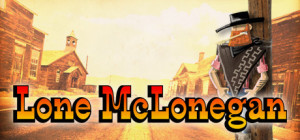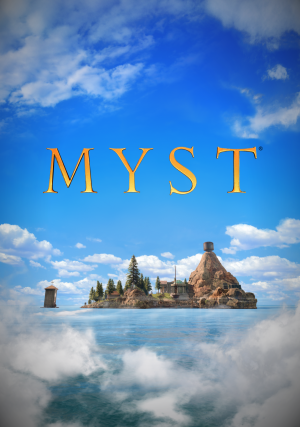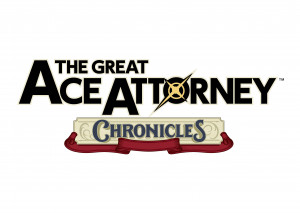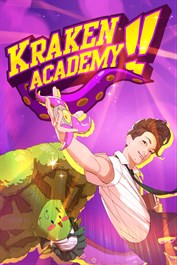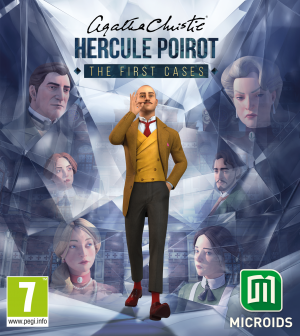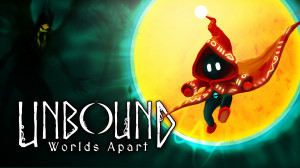Review for Lone McLonegan

Lone McLonegan. The most-wanted outlaw in the Wild West. At least, he is until upstart Bragg Badass dethrones him. So begins a dark tale of revenge and blood as Lone seeks to reassert his title… Well, no, actually Sonomio Games’ classically inspired 2D point-and-click comedy adventure Lone McLonegan is a tale of the eponymous antihero arbitrarily trading random crap for other random crap until the game remembers its plot in the last fifteen minutes of play. But the music’s sure catchy!
The story begins with Lone listening to his home radio, the first of many intentional anachronisms, when he hears he’s no longer the top outlaw after Badass raided the county’s gold reserve. Lone makes his way to Oldewell, known as the “sewer of the west” although it seems to just be a stereotypical American frontier town. There he intends to rob the bank, thus restoring his reputation as the best bandit around. It’s never disclosed what Lone did to become a fugitive in the first place, and with his helpful demeanour it’s hard to imagine he even went so far as littering or spitting in public.
Lone’s initial visit to Oldewell serves as a protracted tutorial of sorts. Only a handful of locations are available at the time, such as the general store, the undertaker’s shop, and the hotel. Throughout this section, which culminates with Lone sneaking into the bank and breaching its safe, players are introduced to the basics of moving and interacting in this dusty Old West world. Using a cycling mouse pointer, you can perform standard actions like observing hotspots with an eye cursor or interacting with a fist, as well as kicking things with a boot. These are rounded out by what I thought was the slightly deformed head of an orange hockey stick with some small clumps of snow on it that I only realized was Lone’s beard and mouth about two-thirds of the way through. Naturally, this mouth pointer is used for talking to people in typical dialog tree fashion and occasionally eating or drinking edible things.
After busting into the bank safe, Lone is caught by none other than Bragg Badass himself, the self-appointed new sheriff in town. Hauled off to jail, Lone must escape and get some training as a gunslinger so he’ll be more prepared to confront Badass next time. From there, the doors are thrown wide open with a huge number of new locations to explore and items to find. Unfortunately, Lone McLonegan provides little direction and less motivation to actually do things with all this newfound freedom. Puzzles are solved simply because they can be, not because Lone has any kind of goal in mind. For example, there’s a whole extended sequence where you have to construct a fake cow in order to get milk from a farmer, which is then given as one of five ingredients to a voodoo lady, so that Lone can receive a defoliant that he only discovers that he needs much later on.
Nearly all of the objectives in the game are multi-stepped, and the cow progression is far from the longest. However, the developers have mistaken quantity of gameplay for quality gameplay. Some of the longest “puzzles” in the game are simply extended chains of fetch quests, wherein Lone takes an item from one person to give to another, usually to get an object that heretofore hasn’t even been mentioned in order to pass it on to someone else. In another such instance, at one point Lone has acquired a piñata-shaped keychain, which he must exchange for a star-shaped keychain, in order to get a candy cane, to exchange for chewing tobacco, which is traded for a bronze disc, and on, and on. It’s very tedious, feels like work, and when you get to the end of such a chain, Lone is seemingly no closer to his goal of defeating Badass than when he started. I was perpetually left wondering what the point of it all was. The lengthiest of these sequences ultimately results in Lone getting a key piece of incidental information that he could have simply asked for without all the unnecessary churn.
One of the issues I had with these fetch quests, aside from the obvious monotony of them, is that they seemed to fly in the face of the protagonist’s own character. For someone who’s supposed to be a dastardly outlaw, Lone is really rather a lame one. He kindly ferries items from one person to another, usually without any hint of reward, and if anyone tells him not to take something, he meekly tucks his tail between his legs and acquiesces. Especially in a genre that frequently sees its heroes taking anything and everything that’s not nailed down, Lone the would-be-most-wanted stands out as a paragon of law abidingness.
With all the coming and going for no apparent reason, the game took me twelve hours to complete. After making comparatively little progress during the first eight of those, I started delving into a walkthrough. While there are vague clues in-game of what can be done, such as needing something sharp to extract a stuck spring, the big problem is finding the inventory items needed to do it. I started out using the guide sparingly, but the last two hours or so of my playthrough I was pretty much devoted to it because I could no longer be bothered to slog through things for myself. Ultimately, Lone finally lines up his gunfight training and the game is over two minutes later when he confronts Badass in an ending so abrupt that even the townsfolk, who have come out to watch the duel, are moved to comment on it. After such a chore, even with the walkthrough, I was expecting a whole lot more.
The world of Lone McLonegan is populated by a wide array of characters, but they tend to be little more than links in the game’s puzzle chains. According to my notes, most of them have names, such as Stagecoach Mary the coach driver, Susan Anderson the telegraph operator, Bald Eagle the Indian chief, Bagman Smokesella the snake oil salesman, and Mustask Trainwagon the train conductor, but darned if I could remember anyone other than Lone and Bragg after the fact. The characters are thinly drawn, consisting of one or two traits each, and seem even thinner because you spend so little time with them compared to all the wandering around trying to figure out what to do.
Beyond Oldewell, Lone has a large number of destinations to explore. There’s a nearby caved-in mine, a railway station, a cemetery, an Indian (as the game refers to it) village, and even another entire town with over a dozen locations itself. It’s all standard Western movie fare and none of them are particularly memorable, although overall it’s nice to play a game that has such a broad scope. Of course, the flip side to that is that it makes things even harder when you’re wandering around lost without a clue. One word of advice: look at everything. There are multiple critical items to be found that aren’t immediately visible and can only be detected by Lone’s description of a hotspot when examined.
The world is depicted in a simple though not simplistic style. Most locations are drawn as basic shapes, though these are filled in with detailed textures that show the grit and grime of the Old West in a fun, colourful way. Many scenes include some animation to liven things up, whether ripples in a pond, dust motes slowly drifting by, or the glow of hot coals at the blacksmith’s. Characters are hand-drawn and animated in such a way that they feel like caricatured paper dolls with no real depth. They fit in well with their surroundings, although I found there was a lack of a cohesive style that was personally distracting. Certain characters are reasonably realistic in their proportions, like Lone and Bragg, while others look like distorted lima beans with no discernible limbs to speak of. Some have bulging eyes that are mismatched in size; some are like overinflated balloon animals with wobbly limbs. They’re all cartoony; they just didn’t feel like they were from the same cartoon to me.
The most standout aspect of Lone McLonegan is its score. Sonomio has sourced a variety of classic Western music tracks that change according to location. Drums kick in when visiting the Indian village, while a Mexican vibe dominates the town of Taquitovile. Generally there’s a Sergio Leone feel to many of the instrumentals, the themes bright and adventurous as opposed to dark and gritty or nerve-wracking. The blacksmith music, featuring complementary fiddle and banjo playing with a catchy beat, I found to be quite the mind worm in particular, and I’d usually pop in for a few moments whenever I was passing by.
None of the characters are voiced, with all lines appearing as subtitles near the speaker’s head. While the English localization is grammatically correct, it’s written in a very formal way, with little if any use of contractions. This is unfortunate as the game is intended to be a comedy, but the nature of the stilted language tends to deflate any potential humour in the jokes. I never laughed once at the verbal exchanges. There are also a handful of visual gags in the game, such as Lone ziplining with a hanger, which work much better, though they are few and far between.
Conversation is conducted through typical dialog trees. Some options will arbitrarily end a conversation when there’s no real reason to, instead of returning to a previous branch in the tree. This means that most chats will have to be navigated multiple times to get all the important information. In a sneaky subversion of dialog trees, some of the ones here actually turn the seemingly innocuous “goodbye” type of option into a critical choice that must be selected in order to progress.
For all of its unevenness elsewhere, Lone McLonegan is one of the few games that really gets saving right. Not only does it automatically record your progress whenever you change rooms, it also provides the ability to create manual saves as well. I found this helpful for moving about the environment when searching for things to do by saving and loading in different areas. While the game provides a fast-travel map, it has one key problem: it’s part of the regular inventory and there are a lot of items in this game. At one point I counted thirty-eight in the inventory bar, which is hidden at the top of the screen until moused over, and I’m sure that wasn’t the max. As the bar only shows a dozen at a time, that means a great deal of scrolling is needed to access the map. Even without a run option or auto-exit function, it’s usually easier and faster to reload a save or else walk to the exit of the current scene, which brings up the map automatically to get around.
The save feature is one of several added “ooh, that’s nice” features that Lone McLonegan has. A bonus minigame challenges players to find sheriff stars in most of the available locations. There’s no reward for finding them all, but it’s a nice diversion when wandering from place to place looking for actual things to do. Even the main menu has a nice touch, with a different little saying appearing next to Lone’s name in the title each time you access it, such as, “I let my horse do the thinkin’” or “So mad he could bite himself. He did it once. He didn't like it.” They don’t impact the game itself or reveal anything meaningful about Lone; they’re just a fun bit of nonsense.
I really wanted to like Lone McLonegan. With so few Westerns and so many variations of what an adventure game is these days, it’s nice to come across a classic point-and-clicker that melds old-school adventuring with an Old West flavour. Sadly, the lack of in-game purpose or direction, the tediously long fetch quest chains, thin characterizations, and an art style that’s not to my personal taste made this much more of a chore than a joy – though I’d certainly be open to a soundtrack. Those looking for a game that doesn’t hold your hand in any way will certainly find it here; just be sure to bring your own motivation because Lone himself surely doesn’t.


